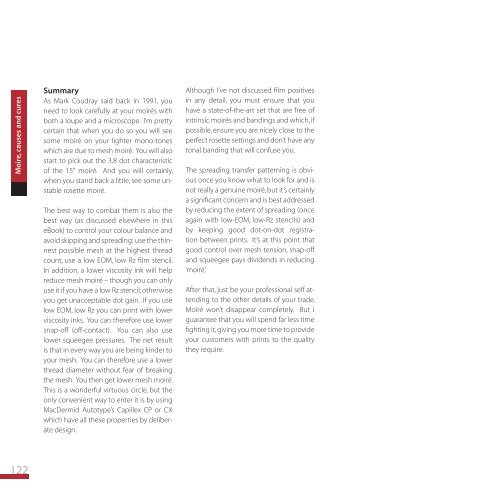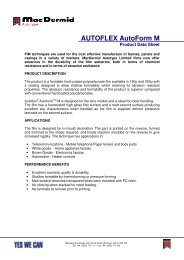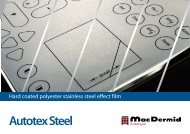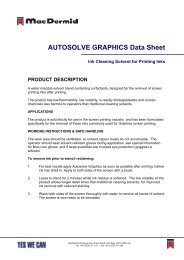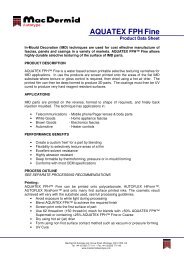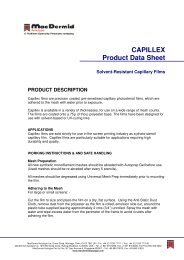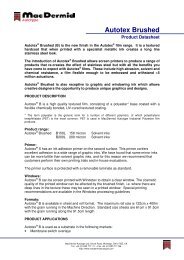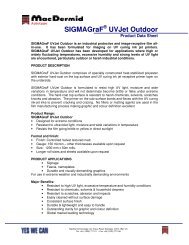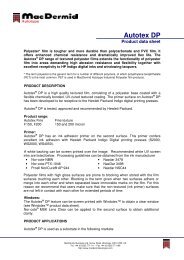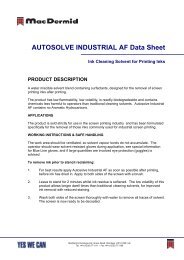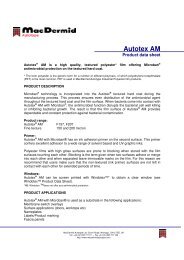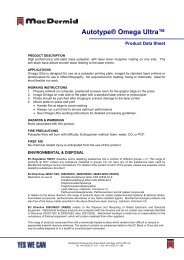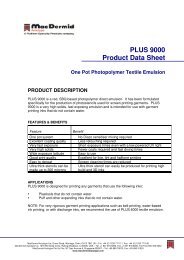Screen E-Book (.PDF) - MacDermid Autotype
Screen E-Book (.PDF) - MacDermid Autotype
Screen E-Book (.PDF) - MacDermid Autotype
- No tags were found...
You also want an ePaper? Increase the reach of your titles
YUMPU automatically turns print PDFs into web optimized ePapers that Google loves.
Moire, causes and curesSummaryAs Mark Coudray said back in 1991, youneed to look carefully at your moirés withboth a loupe and a microscope. I’m prettycertain that when you do so you will seesome moiré on your lighter mono-toneswhich are due to mesh moiré. You will alsostart to pick out the 3.8 dot characteristicof the 15° moiré. And you will certainly,when you stand back a little, see some unstablerosette moiré.The best way to combat them is also thebest way (as discussed elsewhere in thise<strong>Book</strong>) to control your colour balance andavoid skipping and spreading: use the thinnestpossible mesh at the highest threadcount, use a low EOM, low Rz film stencil.In addition, a lower viscosity ink will helpreduce mesh moiré – though you can onlyuse it if you have a low Rz stencil, otherwiseyou get unacceptable dot gain. If you uselow EOM, low Rz you can print with lowerviscosity inks. You can therefore use lowersnap-off (off-contact). You can also uselower squeegee pressures. The net resultis that in every way you are being kinder toyour mesh. You can therefore use a lowerthread diameter without fear of breakingthe mesh. You then get lower mesh moiré.This is a wonderful virtuous circle, but theonly convenient way to enter it is by using<strong>MacDermid</strong> <strong>Autotype</strong>’s Capillex CP or CXwhich have all these properties by deliberatedesign.Although I’ve not discussed film positivesin any detail, you must ensure that youhave a state-of-the-art set that are free ofintrinsic moirés and bandings and which, ifpossible, ensure you are nicely close to theperfect rosette settings and don’t have anytonal banding that will confuse you.The spreading transfer patterning is obviousonce you know what to look for and isnot really a genuine moiré, but it’s certainlya significant concern and is best addressedby reducing the extent of spreading (onceagain with low-EOM, low-Rz stencils) andby keeping good dot-on-dot registrationbetween prints. It’s at this point thatgood control over mesh tension, snap-offand squeegee pays dividends in reducing‘moiré’.After that, just be your professional self attendingto the other details of your trade.Moiré won’t disappear completely. But Iguarantee that you will spend far less timefighting it, giving you more time to provideyour customers with prints to the qualitythey require.122


